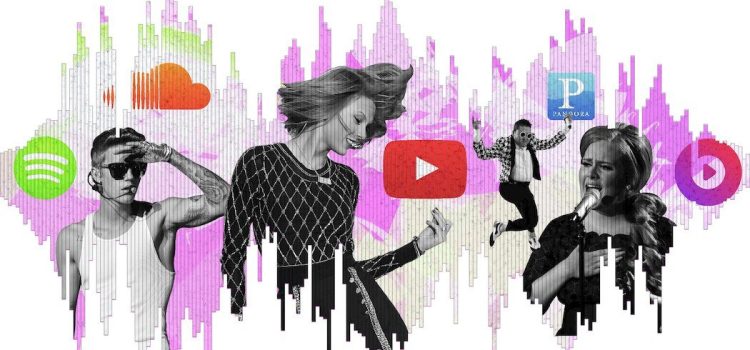
Introduction
The music industry has undergone a dramatic transformation over the past two decades, driven primarily by the advent of streaming services. These platforms have revolutionized how people access and enjoy music, replacing traditional methods like CDs and downloads with a more accessible and affordable alternative. As streaming services continue to grow, they are becoming the backbone of the music industry, redefining its dynamics and shaping its future.
The Rise of Streaming in the Music Industry

Streaming services like Spotify, Apple Music, and YouTube Music have grown rapidly, offering listeners unlimited access to millions of songs at their fingertips. This shift began in the early 2010s, catering to the demands of an increasingly tech-savvy generation.
Unlike traditional methods, streaming eliminates the need for physical purchases or downloads. Instead, users pay a subscription fee or endure occasional ads for seamless music access. This model has disrupted the industry, shifting the focus from ownership to accessibility.
Benefits for Artists and the Industry

Streaming services offer a lot of advantages for both music fans and artists. For listeners, streaming means you don’t have to buy music you can access it all with one subscription. For artists, streaming helps them reach a global audience and connect with fans directly. It also provides useful data to help them understand who is listening to their music.
1. Global Reach
Streaming platforms enable artists to reach a worldwide audience without relying heavily on record labels. Independent musicians, in particular, have benefited from these platforms, finding new ways to promote their work.
2. Data Insights
Streaming platforms provide valuable data, such as listener demographics and preferences. These insights help artists and record labels refine their strategies to engage audiences better.
3. Revenue Opportunities
While concerns remain about streaming payouts, platforms offer new income streams through royalties, promotional partnerships, and exclusive content deals.
The Role of Streaming in the Music Industry
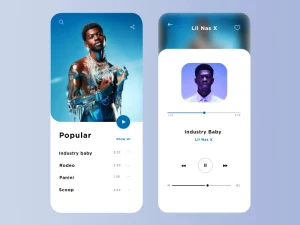
Streaming has become a major part of the music industry. It’s changing how artists make money and how fans find music. Instead of relying on physical sales or radio plays, artists can now share their work worldwide through platforms like Spotify. These services also offer users a wide range of music, from popular hits to new independent artists.
The Growth of Music Subscription Services
Music subscription services have grown quickly in recent years, making it easier than ever to access music. Services like Spotify, Apple Music, and Amazon Music offer affordable subscription plans that allow unlimited listening. Some services also provide family plans or student discounts, making them even more accessible to a wider range of people. These subscription models have become the main way many people listen to music, replacing physical CDs or downloading songs.
The Convenience of Streaming
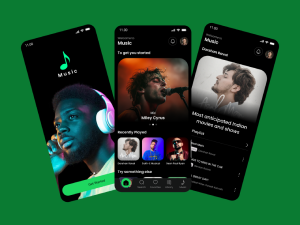
One of the biggest reasons why streaming has become so popular is its convenience. With just a phone or computer, listeners can access music wherever they are. Whether they’re at home, at the gym, or commuting, streaming services allow users to enjoy music on-the-go. Additionally, with features like offline listening, users can download their favorite songs and listen without needing an internet connection, making streaming even more convenient.
The Role of Algorithms in Music Discovery
Algorithms play a big role in how we discover new music through streaming services. These systems use data to recommend songs and artists based on what users have listened to before. While some people love this feature because it introduces them to new music, others feel that the algorithm can limit their choices. Sometimes, it might recommend music that is similar to what they’ve already heard, making it harder for them to find something truly new.
How Streaming Changed the Way We Listen to Music
Before streaming, people had to buy albums or download individual songs to listen to their favorite music. This meant that listening to a wide variety of songs could be expensive and time-consuming. Now, with streaming services, you can listen to almost any song you want for a small monthly fee. It’s much easier for people to explore new music and find new artists they enjoy, all with just a few clicks.
The Power of Playlists
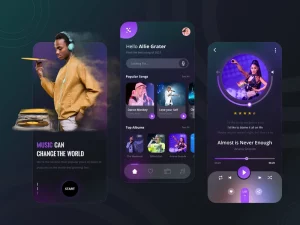
Playlists are another feature that has helped streaming become so popular. Services like Spotify and Apple Music let users create and share playlists with others. These playlists often have themes like “songs for working out” or “chill music for relaxing.” Playlists are also created by the streaming services, helping listeners discover new music. These curated lists are important because they introduce people to songs they may not have found on their own.
Music Discovery for Emerging Artists
Streaming has made it easier for new artists to be discovered. In the past, musicians needed to sign with a record label or get their music played on the radio to reach a large audience. Now, independent artists can upload their music to platforms like Spotify, Apple Music, and SoundCloud and potentially reach millions of listeners. Streaming platforms have given many new musicians the opportunity to gain popularity without the help of big labels.
More Choices for Music Fans

One of the biggest perks of streaming is the huge selection of music available. In the past, if you wanted to listen to a rare album or song, you might have had trouble finding it. Now, streaming platforms offer millions of tracks, from popular hits to deep cuts from small indie artists. This makes it easier for music lovers to enjoy exactly what they like, no matter how niche their taste is.
How Streaming Is Changing the Music Business
Streaming has changed the business side of music in big ways. Record labels no longer have the same power they once did, as artists can now promote their music on streaming services. While streaming gives artists more freedom, it also means they have to work harder to stand out. As streaming grows, record labels have adapted by focusing more on digital strategies and partnerships with streaming platforms.
The Impact of Streaming on Music Genres

Streaming has also changed how people explore different music genres. In the past, people might have only listened to the music that was popular in their area or country. But now, streaming platforms allow users to discover music from all over the world. Whether it’s Latin pop, K-pop, or traditional folk music, listeners have access to a wider variety of genres than ever before. This global reach has helped many artists break into new markets and find fans in different countries.
The Rise of Podcasts and Other Audio Content
Music streaming platforms have also become popular places for other types of audio content, like podcasts. Many streaming services now offer a variety of podcasts, including interviews, stories, and educational content. This shift has made these platforms more than just music players—they’re becoming all-in-one audio entertainment hubs. As a result, listeners can easily switch between music and podcasts, making streaming services a go-to for many people.
How Artists Connect with Fans
Streaming services offer artists new ways to connect with their fans. Many artists use social media to promote their music, and some platforms even let artists share exclusive content with subscribers. For example, artists can release special songs or behind-the-scenes videos on platforms like Spotify or Apple Music. These features help fans feel more connected to the artists they love and provide musicians with direct ways to build a relationship with their audience.
The Accessibility of Music for Everyone
Streaming services make it easy for anyone to access music, regardless of where they live or how much money they have. Before streaming, people in some areas had limited access to music or had to pay a lot for CDs or downloads. But now, with platforms like Spotify and YouTube Music, people can listen to a vast library of songs for a low monthly fee. This has made music more affordable and accessible to people all over the world.
Improving the Experience for Listeners

Streaming platforms are always working to improve the user experience. They are constantly adding new features, such as better music recommendations, high-quality sound, and personalized playlists. For instance, some services have made it easier to find new music through features like “Discover Weekly” on Spotify, which suggests songs based on your listening habits. These innovations are making streaming services even more appealing, and they keep listeners coming back for more.
How Data Shapes the Music Industry
Streaming services collect data on what users listen to, which helps them improve the music experience. They use this data to recommend new songs and create playlists that match a person’s taste. For artists, this data can show them where their fans are located and which songs are the most popular. While this information is helpful, some people worry about how much personal data is being collected.
Affordable Plans for Everyone
Streaming services offer different plans to suit everyone’s needs. Some platforms provide free access with ads, while others have paid subscriptions for ad-free listening. Many services also have discounted plans for students or families. This variety of choices makes it easy for people from all walks of life to find a plan that works for them, which has helped streaming grow so quickly.
Challenges in the Streaming Music Industry
While streaming has made music more accessible, it also comes with some problems. One of the biggest issues is that artists don’t always make enough money from streams, especially smaller artists. Another challenge is the way algorithms work, sometimes making it harder for new or independent artists to get discovered.
Despite its advantages, streaming presents significant challenges:
- Low Payouts: Many artists feel that royalties are insufficient, with smaller musicians particularly affected.
- Market Saturation: The proliferation of platforms makes it harder for new players to compete.
- Algorithm Bias: Streaming algorithms can favor established artists, making it difficult for emerging talent to gain visibility.
The Future of Streaming in the Music Industry
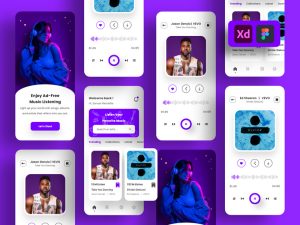
As technology evolves, the streaming music industry is poised for further innovation. Enhanced algorithms, AI-curated playlists, and immersive experiences like virtual reality concerts are likely to redefine the way people engage with music.
Moreover, addressing issues like fair compensation and algorithmic fairness will be critical in creating a more inclusive ecosystem for artists and users alike.
Comparative Analysis of Streaming and Traditional Models
| Aspect | Streaming Model | Traditional Model |
|---|---|---|
| Accessibility | Instant, on-demand access globally | Limited by physical and download availability |
| Cost to Consumers | Affordable subscription/ad-supported | High initial cost for CDs/downloads |
| Revenue for Artists | Low per-stream royalties | Higher per-unit sales, but limited reach |
| Reach | Global and inclusive | Regionally constrained |
| Discoverability | Algorithm-based recommendations | Reliant on marketing and radio play |
Analytical Insights on Streaming Music Industry
| Factor | Impact | Analysis |
|---|---|---|
| User Preferences | Growing demand for convenience and variety | Users favor services offering diverse libraries. |
| Technological Advancements | Improved streaming quality and smart features | Enhances user experience and platform loyalty. |
| Artist Opportunities | Direct fan interaction and independent growth | Helps emerging artists establish their careers. |
| Economic Model | Subscription-based revenue generation | Encourages recurring income streams but with payout debates. |
Conclusion
Streaming services have undeniably become the cornerstone of the music industry. While they bring unparalleled convenience and global reach, they also present challenges that need careful attention. By balancing innovation with fair practices, streaming platforms can shape a sustainable and inclusive future for the music industry.








